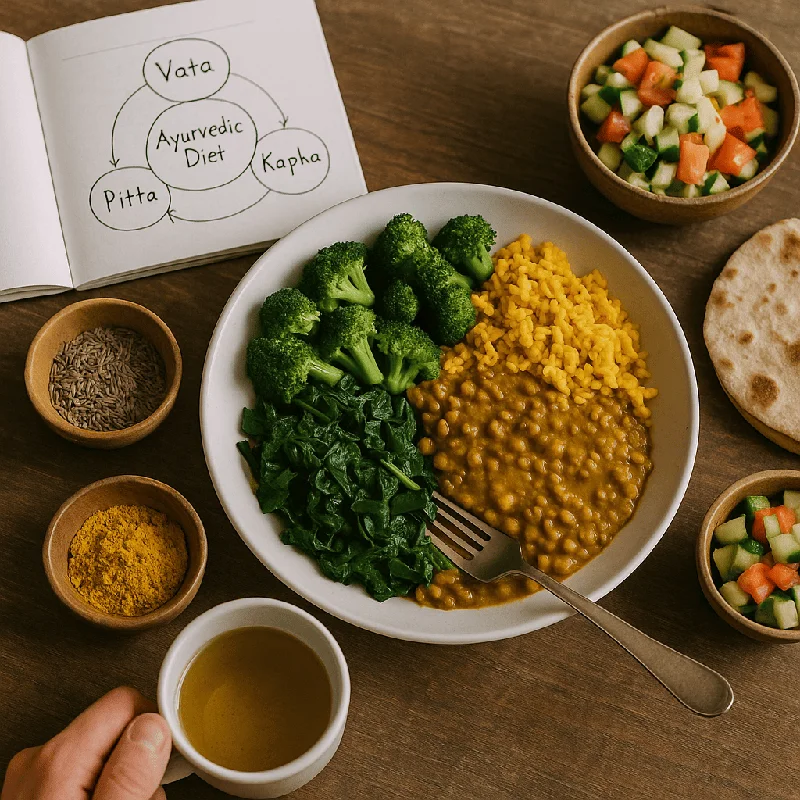Ask Ayurvedic doctor a question and get a consultation online on the problem of your concern in a free or paid mode. More than 2,000 experienced doctors work and wait for your questions on our site and help users to solve their health problems every day.
Shop Now in Our Store
What No One Tells You About an Ayurvedic Diet Chart for Weight Loss

Introduction to Ayurvedic Diet Chart for Weight Loss and Ayurveda’s Approach
So, weight loss. Not the easiest conversation to have over chai, right? Especially when every third headline is shouting something like, “Lose 5 kgs in 10 days!”—usually followed by some weird smoothie cleanse or 100 squats a day. But what if weight loss didn’t have to be such a rushed, punishing thing?
That’s where Ayurveda strolls in—not struts, not charges, just calmly strolls in with 5,000 years of wisdom tucked under its sash.
The Ayurvedic diet chart for weight loss isn't just about cutting carbs or tracking macros. It’s more like tuning a slightly out-of-sync instrument: your body. Instead of following some generic, one-size-fits-all program, Ayurveda looks at you—your habits, your dosha (we'll talk about that), your emotional patterns, even the time you eat dinner.
And that’s the catch (and the charm): it’s personal.
Ayurveda says digestion isn't just what happens in your stomach—it's a whole-body process. A sluggish metabolism (they call it mandagni) can come from overeating, sure, but also from staying up too late, ignoring stress, or even skipping lunch (yes, skipping meals isn’t always helpful, apparently).
So, if you’re looking for the kind of weight loss that doesn't feel like punishment or a fight against your own cravings, this might be worth exploring. Not because it’s trendy. But because it makes sense in that quiet, "ohhh this actually fits me" kind of way.
Here’s what you’ll get from this guide:
-
A better understanding of how your body works—your body, not just a textbook version.
-
Diet and lifestyle practices that feel natural instead of forced.
-
A way to actually enjoy food (yes, including ghee!) while working toward your weight goals.
-
Tips that don’t require a total life overhaul—unless you want one.
Let’s begin by breaking down what Ayurveda really says about all this weight-loss stuff.

Understanding the Role of Ayurveda in Managing Weight Loss
What Ayurveda Says About Weight Loss
Okay, let’s just get this out of the way: Ayurveda doesn’t have a word for “weight loss” in the way modern fitness culture does. The closest terms might be Sthoulya (obesity) and Medoroga (disorder of fat metabolism). But it’s not obsessed with the scale. It’s more concerned with balance.
In Ayurvedic terms, excess weight is usually linked to an imbalance in the Kapha dosha. Kapha, associated with earth and water, governs structure, lubrication, and stability in the body. Sounds like a good thing—and it is—but when Kapha gets excessive, it leads to heaviness, sluggishness, and, well, stubborn fat.
There’s also Agni, the digestive fire. A weakened agni means food isn’t properly digested or metabolized, turning into Ama—a kind of toxic residue that clogs up bodily systems. Ayurveda sees excess fat as not just a calorie issue but a symptom of weak agni and unprocessed ama.
Oh, and here’s the kicker—it’s not just about what you eat. Your emotional state, the season, your sleep habits, even how you chew your food—everything plays a role.
In that way, Ayurveda doesn’t treat weight gain as a “problem” to be “fixed.” It sees it as a sign that something in your body’s internal rhythm is off-beat. And fixing that? Well, that’s where the real magic happens.
How Ayurvedic Lifestyle & Diet Directly Impact Weight Loss
Imagine this: you start your day with warm water and a bit of lemon, take a quiet moment to stretch or meditate, eat breakfast before 9 a.m., and have your biggest meal around noon when your digestive fire is strongest. You’re not counting calories—you’re flowing with your natural rhythm.
That’s kind of what Ayurveda promotes.
The Ayurvedic diet emphasizes fresh, seasonal, easy-to-digest foods tailored to your dosha. If you're Kapha-dominant (you know—stocky build, calm nature, prone to gaining weight), you’ll probably benefit from lighter, warming, and spicy foods to kick that sluggish metabolism into gear.
But it’s not just food—it’s timing. Ayurveda swears by early dinners, ideally before sunset. The idea is to give your body enough time to digest food before winding down for sleep. And no snacking all night. Sorry.
There's also a big emphasis on routine. Your body craves it. Sleep-wake cycles, meals, movement—when these are regular, your system finds stability. And stable systems don’t hold onto excess weight for no reason.
The Importance of Individualized Ayurvedic Approaches for Weight Loss
Here’s where it gets both fascinating and a bit inconvenient: there is no single Ayurvedic diet chart for weight loss that works for everyone.
Wait, what?
Yup. Ayurveda is completely obsessed with the idea of individuality. There are three doshas—Vata, Pitta, and Kapha—and most of us are a mix of two. Your unique combination is called your Prakriti, and it’s the blueprint for how your body responds to food, stress, seasons, and more.
So two people can eat the same “healthy” salad and have wildly different reactions. One might feel energized; the other, bloated and cranky. Ayurveda would say: because it wasn’t aligned with their dosha.
That’s why any solid Ayurvedic plan for weight loss starts with knowing yourself. Not just “oh, I like sweet stuff,” but deeply—your cravings, digestion, energy levels, even how your skin feels in winter. The more attuned you are, the better Ayurveda works.
So, while we will get into general food and lifestyle suggestions (coming in the next parts), keep this in mind: customization is king in Ayurveda. Or queen. Or, you know, whatever sovereign identity you vibe with.
Ayurvedic Dietary Guidelines for Weight Loss
Ah yes, the part we’ve all been waiting for: what to eat (and not eat) when you're following an Ayurvedic diet chart for weight loss. This isn’t a crash diet. You won't find "no food after 6 p.m." or "just celery juice for breakfast" here. Ayurveda is more like, "Hey, let’s understand your body and work with it—not against it.”
Here’s the thing: Ayurvedic dietary choices are based on qualities, not just nutrients. Is a food light or heavy? Heating or cooling? Moist or dry? These qualities either soothe or aggravate your dosha, and weight gain is often the result of eating foods that just don’t gel with your constitution.
Let’s break this down into bite-sized (hah) chunks.
Foods Recommended by Ayurveda for Weight Loss
If you’re dealing with excess Kapha—which, again, is often the dosha behind weight gain—your food should ideally be:
-
Light in nature,
-
Dry and warming, and
-
Easy to digest.
That means:
-
Cooked vegetables (especially bitter greens like spinach, mustard leaves, and fenugreek)
-
Spices like turmeric, ginger, black pepper, cinnamon (your metabolism will thank you)
-
Legumes like mung beans and red lentils
-
Grains like barley, millet, and quinoa
-
Fruits like apples, pears, pomegranate (nothing too sweet or heavy)
-
Herbal teas like ginger, cumin-fennel-coriander (CFC tea is a classic!)
One underrated hero? Triphala. Often taken at night, it’s known to gently detoxify the gut and improve elimination—critical for sustainable weight loss.
But don’t skip meals. That’s a rookie mistake. Just eat foods that are agni-friendly—which means they boost, not bog down, your digestion.
Foods Ayurveda Suggests Avoiding for Weight Loss
Let’s talk “no’s” — but in a “you deserve better” kind of way, not a “you’re being punished” kind of way.
Avoid:
-
Heavy dairy (especially cheese, cold milk, and yogurt at night)
-
Fried and oily foods (yes, even samosas)
-
Cold or iced drinks (they put out your agni like dumping water on a campfire)
-
Excessively sweet, salty, or sour foods (these increase Kapha)
-
Red meat or overly processed meats
-
Leftovers and microwaved meals (dead food = dull digestion, according to Ayurveda)
And yeah, sorry, but that giant salad you think is healthy? If it’s raw, cold, and eaten late at night, it’s a digestive disaster in Ayurvedic terms.
Meal Planning and Timing Tips in Ayurveda for Weight Loss
Here’s a wild idea: eat your biggest meal when the sun is at its peak. Sounds odd in today’s dinner-heavy culture, but Ayurveda insists that lunch (around 12–1 p.m.) is when your digestive fire (agni) is strongest.
-
Breakfast: light and warming — think spiced porridge or a cup of warm almond milk with dates.
-
Lunch: hearty but balanced — grains, cooked veggies, light proteins.
-
Dinner: small, soupy, and before 7 p.m. if you can swing it.
And snacking? Only if you're actually hungry, not bored or stressed.
Oh, and chew. Slowly. Like, embarrassingly slow. Digestion starts in the mouth, and Ayurveda's big on that.
Hydration and Beverage Recommendations for Weight Loss
Warm. Water.
No, really. That’s the Ayurvedic hydration secret. Cold drinks slow down agni. Warm water—sipped throughout the day—helps flush toxins and stoke digestion.
You could also try:
-
Jeera (cumin) water in the morning
-
Ginger tea before meals
-
Coriander or fennel infusions after meals
-
Occasional buttermilk spiced with rock salt and cumin (post-lunch)
Avoid drinking large amounts during meals—it’s like dousing a fire mid-burn.
Ayurvedic Lifestyle Practices Specifically Beneficial for Weight Loss
Sometimes we focus so much on food, we forget that how we live has just as much to do with weight gain (or loss) as what we eat. Ayurveda calls this the Dinacharya—daily routine. And it turns out, the way you brush, bathe, and sleep might be just as important as what’s on your plate.
Daily Ayurvedic Routines (Dinacharya) to Manage Weight Loss
Let’s paint a picture:
You wake up early (before sunrise if you’re really going for gold), scrape your tongue, sip warm water, stretch, maybe oil your body before bathing… and you haven’t even eaten yet, but your system is already firing up.
This isn’t spa stuff—it’s metabolism optimization.
Here’s a simplified daily plan:
-
Wake by 6 a.m.
-
Hydrate with warm water + maybe lemon or jeera
-
Eliminate waste (yes, pooping daily is essential in Ayurveda)
-
Exercise or yoga to get lymph and energy flowing
-
Abhyanga (self-oil massage) 2–3x/week to stimulate circulation
-
Bath + meditation or breathwork
-
Eat on time, sleep by 10 p.m., repeat.
This may sound idyllic. It kinda is. But start with one or two of these, not all. The goal is rhythm, not rigidity.
Sleep Patterns and Ayurvedic Guidelines Relevant to Weight Loss
This one’s overlooked but wildly important. Staying up late messes with everything: hormones, digestion, cravings. Ayurveda says the best sleep is between 10 p.m. and 4 a.m. That’s when your body heals and resets.
Plus, ever notice how late-night scrolling = late-night snacking?
Try:
-
Going to bed before 10:30 p.m.
-
Limiting screens at night
-
Creating a pre-bed wind-down (even 10 minutes of journaling helps)
-
Herbal teas like Brahmi or chamomile
The better you sleep, the less cortisol (stress hormone), and the fewer cravings you’ll have.
Ayurvedic Personal Care Practices for Weight Loss
Yes, there are beauty rituals. But also some that go skin-deep—literally.
-
Dry brushing (Garshana) before a shower helps stimulate lymphatic flow and exfoliates ama.
-
Nasya oil (a few drops in the nostrils) can help regulate mood, digestion, and sleep.
-
Triphala eye wash or detox baths with rock salt can help reduce emotional stress (a sneaky weight-gain culprit).
It’s all connected. Your skin, gut, mind—Ayurveda sees no separation.

Yoga & Breathing Techniques for Weight Loss
Not just about stretching into complicated poses or standing on your head. In Ayurveda, yoga is part of the whole reset-the-system plan, especially when it comes to calming Kapha, energizing sluggish metabolism, and managing emotional eating.
Yoga Asanas Specifically Recommended for Weight Loss
Here’s the trick: move in a way that energizes you—not exhausts you.
Ayurvedic-friendly asanas for Kapha/weight loss include:
-
Surya Namaskar (Sun Salutations — do 6–12 rounds daily)
-
Trikonasana (Triangle pose)
-
Navasana (Boat pose)
-
Utkatasana (Chair pose)
-
Twists — they stimulate digestion and detoxify organs
Consistency over intensity. Even 20 minutes a day is gold.
Pranayama (Breathing Exercises) That Improve Weight Loss
Breath controls the nervous system. Nervous system controls hormones. Hormones control fat storage. It’s a domino effect—and Pranayama is your power move.
Best ones for weight management:
-
Kapalabhati (Skull Shining Breath) – energizes and detoxifies
-
Bhastrika (Bellows Breath) – increases internal heat
-
Nadi Shodhana (Alternate Nostril) – calms stress and improves sleep
Start slow. These aren’t just warm-up routines—they’re metabolic regulators.
How Often to Practice Yoga & Breathing Techniques for Weight Loss
This one’s simple: daily, even if just a little.
-
Yoga: 4–6 days a week, 20–45 minutes is enough.
-
Breathwork: 10–15 minutes daily, ideally in the morning.
Early mornings are best for Kapha types. You’ll feel lighter, clearer, and less likely to binge by mid-afternoon.
Stress Management and Emotional Health Advice for Weight Loss
Weight isn’t just physical—it’s emotional, too. You know that thing where you crave junk when stressed? Ayurveda knew about that long before it had a hashtag.
Emotions can clog the body just like poor digestion. Sadness, grief, anxiety—they all impact agni, doshas, and metabolism.
Ayurvedic Techniques to Reduce Stress Related to Weight Loss
Ever tried Shirodhara? Warm oil slowly poured on your forehead. Not always accessible, but if you can swing it—wow.
At home though:
-
Abhyanga with calming oils (like Brahmi or Ashwagandha-infused)
-
Aromatherapy with sandalwood or lavender
-
Silence time — just 5 minutes a day can shift things
Also, avoid multitasking while eating. It's a weird stress amplifier. Be with your food, even if it’s just a khichdi.
Meditation and Mindfulness Practices Beneficial for Weight Loss
Nothing fancy required here. Just sit. Close your eyes. Breathe. Even 3 minutes.
Try:
-
Trataka – candle gazing, helps focus the mind
-
Mantra repetition – even a simple “So Hum” calms scattered thoughts
-
Yoga Nidra – guided body relaxation that can restore the nervous system
You’re not trying to “empty” your mind. You’re just giving it space to breathe.
Emotional and Psychological Considerations in Ayurveda for Weight Loss
Ayurveda doesn’t just ask “what are you eating?” It asks “what’s eating you?”
People with Kapha imbalance often carry emotional weight. Loneliness, stagnation, old grief—it shows up in the body.
So when you feel stuck, heavy, unmotivated—maybe it’s not just diet. Maybe it’s time to lighten something inside, too.
Be kind to yourself. That’s Ayurvedic, too.
Practical Ayurvedic Home Remedies and Recipes for Weight Loss
Now, let’s get into the nitty-gritty. You know, the “what can I actually do in my kitchen today” kind of stuff.
Sometimes you don’t want another theory. You want something simple. Tangible. Maybe even a little messy.
Ayurveda’s full of that kind of thing. Spices that double as medicine, ingredients already in your pantry, routines that feel like rituals.
Simple and Effective Home Remedies for Weight Loss
These aren’t miracle cures—but they are slow, steady allies. Think of them like long-time friends. They show up every day and nudge you back into balance.
-
Cumin-Fennel-Coriander Tea (CFC Tea)
Boil 1 tsp each of cumin, fennel, and coriander seeds in 2 cups of water. Reduce to 1 cup. Sip warm after meals.
Why? It boosts digestion, reduces bloating, and gently detoxifies Kapha buildup. -
Lemon-Honey Water (in moderation)
Squeeze half a lemon into warm water, add a tsp of raw honey (never heat the honey!). Drink first thing in the morning.
Why? Jumpstarts metabolism, but avoid if you’re Pitta dominant. -
Triphala at Night
1 tsp powder with warm water before bed.
Why? Regulates digestion and elimination. When your gut’s clear, your weight follows. -
Dry Ginger Powder & Rock Salt
A pinch before meals can wake up sluggish digestion.
Ayurvedic Recipe Ideas Specifically Beneficial for Weight Loss
Forget smoothies and protein bars for a sec. These are the kind of meals your gut might actually throw a little celebration over.
-
Khichdi (but with a twist)
Use mung dal + barley instead of rice. Add veggies like lauki (bottle gourd), spinach, and carrots. Spice it with cumin, mustard seeds, turmeric, and ginger.
Easily digestible, grounding, and still warming. -
Spiced Veggie Stew
Lightly sauté seasonal veggies in ghee with mustard seeds, cumin, turmeric, a pinch of hing (asafoetida). Add water, simmer. Great for dinner. -
Barley Upma
Roasted barley rava cooked with onions, curry leaves, green chilies, and veggies. It’s light, filling, and great Kapha food.
Preparation Tips and Guidelines for Ayurvedic Remedies
A few reminders that matter more than you’d think:
-
Eat food warm. Cold kills agni.
-
Use freshly ground spices if possible—they’re more potent.
-
Cook with love. (Yeah, it sounds hippie, but it matters.)
-
Avoid reheating meals more than once.
-
No TV or scrolling during meals. Focus = digestion.
Ayurveda believes food isn’t just fuel—it’s a message. What are you telling your body?
Common Mistakes & Misconceptions About Ayurvedic Lifestyle for Weight Loss
Ayurveda is having a bit of a moment, which is both great and… tricky.
Because while more people are discovering it, many are misapplying it. And that can do more harm than good.
Common Myths About Ayurveda & Weight Loss
Let’s bust a few.
Myth #1: Ghee makes you fat.
Nope. Ghee, in moderation, actually helps burn stubborn fat by improving digestion and lubricating the digestive tract.
Myth #2: Ayurveda means raw salads and herbal pills.
Not even close. Raw food is often discouraged in Ayurveda, and pills aren’t a shortcut to balance.
Myth #3: You need to be vegetarian.
Not necessarily. Some constitutions benefit from small amounts of ethically sourced meat—Ayurveda isn’t rigid.
Myth #4: Ayurveda works slowly.
It’s actually fast when you’re aligned. The "slow" part is usually unlearning bad habits.
Typical Mistakes People Make When Adopting Ayurvedic Lifestyle for Weight Loss
-
Trying to follow all dosha rules at once (don’t!)
-
Skipping meals in the name of “detox”
-
Eating “Ayurvedic” food but at the wrong times (timing is everything)
-
Overdoing herbs without guidance
-
Thinking Ayurveda = Indian cuisine (it’s a science, not a menu)
How to Avoid These Mistakes
-
Start slow—even one habit (like early dinners) can shift your whole system.
-
Don’t self-diagnose your dosha after a BuzzFeed quiz.
-
Work with a qualified Ayurvedic practitioner if you can.
-
Focus on digestion, not just calorie count.
-
Be patient. Not passive—but patient.
Ayurveda isn’t here to impress. It’s here to restore.
Real-Life Success Stories & Testimonials Related to Weight Loss
These aren’t six-pack transformations. They’re real wins.
Inspirational Stories from Individuals Who Improved Weight Loss Through Ayurveda
Neha, 34, Mumbai:
“I used to skip breakfast and snack at night. My digestion was awful. Just switching to warm breakfasts and eating dinner before 7 p.m. made me lose 4 kg in a month. I didn’t feel like I was even trying.”
Raj, 41, London:
“I started daily Abhyanga and switched my coffee habit for spiced tea. My cravings dropped, and my anxiety too. I’ve lost 6 kg in 3 months—no gym involved.”
Real-world Benefits & Results Achieved Using Ayurvedic Recommendations
-
Improved sleep (which helps hormones rebalance)
-
Reduced bloating and indigestion
-
Emotional stability = fewer binge episodes
-
Weight loss that stayed off, because the habits stuck
The best part? People report feeling better, not just looking better.

Scientific Evidence Supporting Ayurvedic Lifestyle & Diet for Weight Loss
Okay, so what does science say? Is Ayurveda just “woo,” or is there data?
Turns out, yes—quite a bit.
Research Findings About Diet’s Impact on Weight Loss
-
A 2011 study in the Journal of Clinical Gastroenterology showed Ayurvedic dietary principles improved metabolic parameters in overweight patients.
-
A 2017 review in Evidence-Based Complementary and Alternative Medicine found that Ayurvedic interventions (diet + herbs + lifestyle) led to significant reductions in BMI and waist circumference.
-
Mindful eating—central to Ayurvedic meal practices—has been shown to reduce emotional eating and support sustainable weight loss.
Clinical Studies Confirming the Benefits of Ayurvedic Practices
-
A pilot study on Triphala confirmed its effectiveness in reducing body weight and improving lipid profiles.
-
Yoga, when paired with Ayurvedic diet, showed significant impact on weight regulation in obese adolescents (International Journal of Yoga).
Science is catching up to what Ayurveda’s been quietly doing for centuries.
Expert Opinions on Ayurvedic Approaches to Weight Loss
Dr. Vasant Lad, a renowned Ayurvedic practitioner, puts it beautifully:
“You can’t heal the body without also healing the habits that led it into imbalance.”
Nutritionist Dr. Suhas Kshirsagar emphasizes that weight loss is a byproduct of balance—not the goal itself. When digestion, sleep, and emotions are aligned, the body resets naturally.
Conclusion & Summary of Ayurvedic Recommendations for Weight Loss
So. We’ve come a long way together—through doshas, digestion, dinner timings, and dry ginger powders.
Let’s pull it all together.
Ayurveda doesn’t offer shortcuts. It offers insight. Into how you eat, sleep, breathe, and even feel. And when all those things come into harmony, your body lets go of what it doesn’t need—including excess weight.
To recap:
-
Eat fresh, warm, light foods tailored to your dosha
-
Follow a routine—sleep early, rise early, eat on time
-
Move daily—through yoga, walking, or dancing in your living room
-
Care for your emotions—they matter as much as your meals
-
Be gentle with yourself—and consistent
And if all this feels like a lot—just start somewhere. A cup of cumin tea. A dinner before sunset. A breath before the next bite.
Ayurveda meets you where you are.
Ready to go deeper? Consult a certified Ayurvedic practitioner who can tailor a plan for your body, your lifestyle, your goals. Your weight loss journey can start with balance—not battle.
Frequently Asked Questions (FAQ) about Ayurvedic Lifestyle for Weight Loss
1. Can an Ayurvedic diet really help with weight loss without exercise?
Yes—but movement is part of balance in Ayurveda. Walking, yoga, or simple morning routines can enhance results, but the diet itself plays a central role.
2. Do I have to be vegetarian to follow an Ayurvedic weight loss plan?
Not necessarily. Ayurveda recommends light, digestible proteins, and in some cases, small amounts of meat or fish may be appropriate depending on your dosha and condition.
3. How long does it take to see results with an Ayurvedic diet chart for weight loss?
It varies, but many people notice changes in energy and digestion within 2–3 weeks. Sustainable weight loss may take longer, but tends to be lasting.
4. What time should I eat dinner according to Ayurveda?
Ideally before sunset, or at least by 7 p.m. Late-night eating slows digestion and increases Kapha accumulation.
5. Is it okay to skip breakfast on an Ayurvedic plan?
Usually not. Ayurveda sees breakfast as essential, especially something warm and grounding to kindle digestion.
This article is checked by the current qualified Dr Sujal Patil and can be considered a reliable source of information for users of the site.

